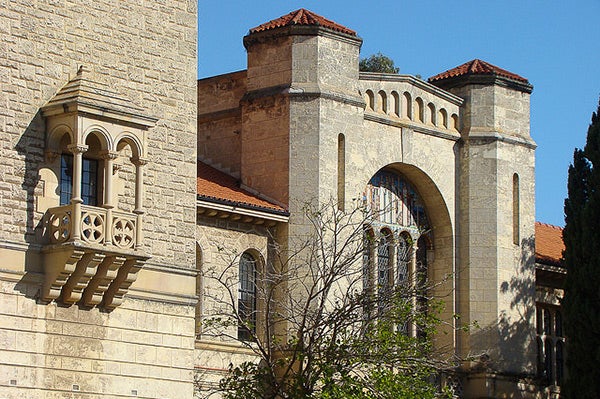|
November 5, 2012
Australian university joins Stanford's open-source online platform
Class2Go, developed by a group of Stanford engineers, will be the basis for online courses at the University of Western Australia accessible through mobile devices. The mobile app will then be available for use by Stanford – and anyone else. By R.F. MacKay

The University of Western Australia plans to launch two courses on Class2Go by March 2013. (Photo: Don Pugh/Creative Commons)
The beauty of open-source technology is that people around the world can build things together. Like bricolage, technology can grow flexibly as developers respond directly and creatively to users' needs and imaginations.
That is the case with Class2Go, Stanford's homegrown, team-built platform for hosting online classes. When the director of a software center at an Australian university caught a glimpse of the platform after its September launch, he immediately envisioned how his university could adapt it and at the same time contribute to it.
He called the platform simply "revolutionary."
David Glance, director of the Centre for Software Practice at the University of Western Australia (UWA), was at Stanford last week meeting with Class2Go's engineers and other Stanford Online staff members to share ideas and map out future collaborations.
"This is one of the benefits of our being open source," said Jane Manning, Stanford Online's production and platform manager. "Others can build things we haven't gotten around to yet."
Advantages of open source
Indeed, it was the open-source aspect of Class2Go that immediately enthused Glance, who spent several years working for Microsoft and in Silicon Valley. He was familiar with the available course-hosting platforms, but "the fact that Class2Go was open source, for me, was the big thing," he said.
There are both practical and philosophical reasons for that. Philosophically, following what Glance laughingly called "the path of the righteous," free open-source technology ensures access and knowledge for everyone, not just for those who can afford it.
And, on a practical level, open source permits schools to adapt technology to their own needs. Right now, most students using Class2Go probably use it on their laptops. Glance is interested in mobile use that goes beyond squishing web page images down to the size of a phone screen. Rather, his group wants to reorganize the layout to change the student experience.
Universities throughout Australia are showing extraordinary interest in online learning and massive open online courses, or MOOCs, Glance said. UWA at first was looking at the Coursera platform, which the University of Melbourne has partnered with. "But then I saw the announcement of C2G," he said, "and a light bulb went off. I thought it was a fantastic opportunity. I wrote [to the Class2Go team] and said we'd like to use the platform for our own programs, and I also offered our mobile app to Stanford."
Starting with iPhones, and then moving on to iPads and Android phones, the mobile app will enable students to take an entire course on the phone. On the left of the screen is a menu with announcements, course information, course materials, forums, problem sets and videos.
"The whole idea of a course on a phone is very appealing," Glance said. "We're really living in a post-PC world; there are more mobile phones than computers. Our students aren't bringing laptops to campus anymore anyway. So it would be really nice to be able to take a course on the phone, picking up where you left off in a seamless synchronization across devices."
Glance has spent the past few months meeting with faculty throughout his university, located in Perth, to spread the online gospel. Overall, he said, the university has been "incredibly supportive," and there is lots of media interest, both in MOOCs in general and in UWA's collaboration with Stanford in particular.
"We're concentrating on mobile, but we might also want to help out with the platform itself," he said, echoing Manning's belief that open source is a good way of acquiring committed partners, wherever they may be. Glance also wondered if other schools that eventually sign on to Class2Go might collaborate among themselves, sharing classes and technology. For example, he said, UWA is a member of the Worldwide Universities Network, an international organization of research universities, which is considering pooling resources for online learning. UWA also has close ties to Chinese universities.
Oceanography and sociology
UWA's plan is to launch two courses on Class2Go by March 2013, when its next semester starts: One will be in sociology, the other in oceanography, drawing on the resources of the university's well-known Oceans Institute. They will be both for internal students (using "flipped" classrooms, with students watching videos before class) and for the general public as MOOCs. An astronomy course will follow, taking advantage of the university's proximity to the Square Kilometer Array, the largest radio telescope in the world.
Ahead are all sorts of nuts and bolts for UWA and Stanford to work out: adjusting the platform, making branding decisions, deciding how and when to release the source code. But it's obviously the start of a beautiful friendship. "To use an American expression," Glance said, "we're psyched."
So is the Class2Go team. "We're thrilled that David is using Class2Go, both because of the work that he's doing on it and also because of the work that it's encouraging us to do," Manning said. "I'm hopeful that other universities will be encouraged by UWA's adoption of Class2Go to consider trying it themselves."
-30-
|